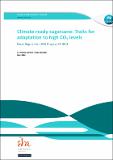| Abstract | Recent work in Brazil and Florida had shown strong responses of sugarcane to elevated CO2, even under well-watered conditions. These results were not expected from current understanding of leaf physiology, given that sugarcane is a C4 plant, possessing a photosynthetic pathway that concentrates CO2 and achieves close to optimal rates of carbon fixation even at current low levels of CO2. The results suggested that the mechanisms by which elevated CO2 affects sugarcane may not be fully understood or, at least, that there may be genetic variation in responses. Fully capturing the benefits of rising CO2 could assist the sugarcane industry in adapting to climate change and offsetting potential negative effects associated with rising temperatures and recurring droughts, if they were to become more frequent. The main objectives of this project was therefore to contribute to the sugar industry’s adaption to climate change by conducting experiments to determine the mechanisms by which rising CO2 affects sugarcane, assessing the genetic variation in CO2 responses and the potential these provide for selecting ‘climate-ready’ genotypes for the future, and incorporating these findings into improved modelling approaches to be able to better represent the effects of future CO2-enriched climates on sugarcane crops. |

